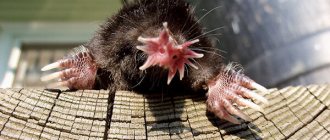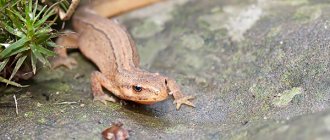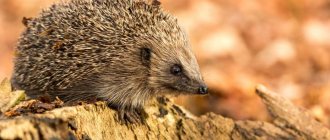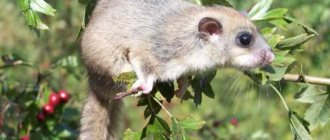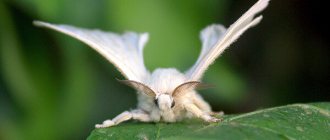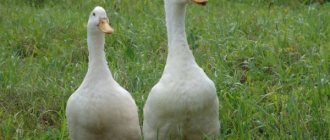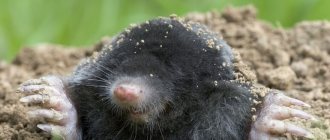People know little about the numerous underground inhabitants living with them on the same planet. One of their representatives is the mole - an amazing small creature capable of living in cold and damp earth, despite numerous threats to its life.
Although moles appear on the surface extremely rarely, they have natural enemies who are not averse to eating them. What is the life expectancy of a mole in such harsh survival conditions? As science says, it all depends on its species and habitat.
Description of the mole
There are several varieties of moles in the world, each of which differs in its size, habitat and habits, but they also have similar features. They belong to the class of mammals and the order of insectivores, and the average life expectancy of moles in nature is 4 years, although there are also long-livers who manage to live up to 7 years.
Among these animals there are very tiny specimens, whose height does not exceed 6-7 cm (for example, Uropsilus soricipes, the Sichuan mole shrew), and larger representatives, almost giants in the underground kingdom - the Ussuri mogera, growing up to 21 cm in length.
Weight also depends on the variety of these mammals and may not exceed 12-15 g for some and reach 300 g for others. Moreover, both small and large moles have a life expectancy of 4-5 years.
Reproduction and lifespan
Moles, in a sense, are hermits leading a solitary lifestyle. They pair up only during the rutting season, when they mate for a short period of time.
Mating of males and females occurs once a year - in early spring. However, there are exceptions, for example, in Belarus, females manage to give birth twice during the year.
Fertilized females bear offspring for 35-42 days. The average litter consists of 6 cubs, but sometimes up to 9 can be born. Only the female builds the nest for the brood. Babies are born completely naked and blind.
Intensive feeding of young animals continues for 5-8 weeks. Only the female provides food for the cubs; the male does not take any part in feeding and raising the offspring.
By about two months of age, young animals begin to show increased aggression towards their relatives. During this period, the cubs leave the parental nest, and each of them digs its own system of passages, moving on to an independent lifestyle.
Mass settlement of young moles occurs in July-August. This process takes place very quickly; within a day, a young mole can be 700 meters away from the birth nest. Young animals reach sexual maturity in 6-12 months. Next spring, the young are ready to mate and reproduce.
Common features in the structure of moles of different species
No matter how different these animals are in size, they have common characteristics that allow them to live underground. Among them:
- An elongated body in the shape of a rounded bar.
- The head has a cone-shaped muzzle that ends with a nose - a proboscis.
- Animal ears are vestigial pieces of skin that look more like twisted ridges protruding from the hair.
- Vibrissae (hard hairs) located on the tail, which help moles move in underground labyrinths in any direction, even backwards.
- The eyes of animals practically do not function, since when living in complete darkness they were replaced by perfectly developed hearing, touch and smell.
- Well-developed small teeth, ranging from 34 to 44 pieces, depending on the type of mole, are not adapted to bite into the ground, but are used for hunting insects and soil invertebrates.
- Animals' fur grows upward and bends perfectly in different directions, rather than covering the body in one direction, as in other mammals, which makes it easier for them to move underground and protects them from pollution.
- The paws of moles are turned palms out and serve as a kind of shovels for discarding earth when making holes.
Depending on where moles live, they differ in the color of their fur, which can range from brown and gray to deep black.
Sense organs
The eyes are small, very poorly developed and almost completely covered with skin. The mole has no ears .
The auditory openings are also covered with skin. But the animal’s hearing is remarkably developed.
Which sense organs are better developed in a mole? The frequency sound conductivity of the soil is available to him . The sense of smell is well developed. By smell, he finds food in the ground.
Tactile hairs are distributed throughout the body. Thanks to them, he senses worms located 50-70 cm from him .
Also an integral part is a 2-centimeter tail, which is covered with hairs. When the mole lifts its tail up, it feels the ceiling of the dug tunnel . If he does not feel the ground, he returns to his hole.
Lifestyle of underground inhabitants
It is probably easier to list the places where moles do not live, since these mammals are distributed almost everywhere. They are only found where the soil is not suitable for them due to its density or composition. So, they don't like:
- Sandstones and too dry places where it is difficult to get food.
- Tundra and forest-tundra due to too deep freezing of the ground.
- Places where groundwater is close to the surface.
- Forests overgrown with powerful trees and shrubs, whose root system is intertwined into a single dense “carpet”.
Moles prefer soft soil, which makes it easy to dig underground tunnels. They often choose vegetable gardens in their summer cottages and garden plots as their home, since the soil there is constantly loosened and fertilized, which leads to an increase in the number of worms and insects that they feed on.
Animal eye degeneration as a form of natural selection
From the point of view of evolutionary theory, the gradual simplification of the structure of the mole's eyes and the loss of many functions by them is a way of adapting to the lifestyle that this animal leads. Moreover, the regression of the animal’s vision system is associated not only with the lack of need for a clear visual picture, but also with the harmfulness of full-fledged eyes underground.
For example:
- If a mole had normal large eyes, like, say, rats or mice, then with constant digging of underground passages, earth and dust would get into them. This would lead to eye contamination, inflammation, suppuration and death of animals. The smaller the eyes, the more difficult it is to damage them, and when they are constantly closed with eyelids, they are reliably protected from external influences;
- Since the sense of smell is much more important for moles, most of the analyzers in the brain are responsibly focused specifically on processing information from olfactory receptors (in star-nosed moles, the sense of touch also plays an important role). The involvement of extensive brain structures in processing visual information would not be rational.
The photo below shows the eye of the Iberian mole:
By and large, moles at this stage of their evolution are moving towards the complete disappearance of their eyes. This form of natural selection, according to different classifications, is:
- Driving - with it, an advantage in survival is found in animals that deviate from the norm of development of a particular trait. The norm is predominantly open, not very small eyes, but in the case of moles, individuals with constantly decreasing eyes that close with eyelids more often survived. That is, natural selection moves these animals towards complete degeneration of vision.
- Cutting off, since individuals with “normal” eyes died more often due to eye lesions.
By the way, it is precisely these forms of selection that are characteristic of almost all animals with certain reduced organs. Including for people who have practically degenerated the muscles that move the ear, or, for example, the coccyx, in the place of which their ancestors had a tail.
Mole nutrition
The threat of dying from hunger is that these animals have a very fast metabolism, to maintain which males require up to 130-150 g, and females up to 80 g of food per day. At the same time, the question of how long a mole lives in general fades into the background. The lifespan of this mammal without food will be only 17 hours.
That is why moles build storerooms in their multi-meter burrow corridors where they store earthworms. They are their main source of food, although mole crickets, chafer larvae, and cutworm caterpillars are often included in the mole menu. To immobilize their prey, these animals bite the head of the prey, leaving it alive, but making it impossible to crawl away.
The feeding regime of moles is such that they can swallow from 30 g to 40 g of worms at one time, but the meal lasts at least half an hour. After five to six hours, the animals require the next portion of food, after which they fall asleep. After resting for 3-4 hours, the moles go in search of food, and the whole process is repeated.
These mammals rarely leave their shelters, so it is almost impossible to see them hunting on the surface.
How are animals useful and what is their harm?
Most people have the opinion that moles are extremely harmful animals that feed on parts of plants and chew off their roots. This is a big misconception!
The benefits of moles are as follows:
- They eat pests of gardens and vegetable gardens, as well as their larvae;
- Destroy slugs;
- They can eat the cockchafer, mole cricket and wireworm;
- They loosen the soil and make drainage passages, which is useful for the air and water regimes of the soil.
However, everything is good in moderation. With a large number of moles on the site, the benefit turns into harm. Animals tear up flower beds and lawns, cutting off the roots of cultivated plants.
We should also not forget that the main food for moles are earthworms, which have a beneficial effect on improving the quality characteristics of the soil on the site and improve its fertility.
So, you have been presented with information about moles, their lifestyle, and reproduction. We tried to describe and characterize this animal as fully as possible, so that readers have a correct idea of \u200b\u200bmoles.
If this animal suddenly chooses your area for its habitat, you must decide for yourself: drive it away or leave it with your neighbors. This approach is due to the fact that moles have both benefits and harm.
Habitat
How long a mole lives often depends on its habitat. We do not mean specific regions here, since this mammal is distributed everywhere, with the exception of the polar regions and countries with cold or too hot climates.
An important criterion for the habitat of these animals is the looseness of the soil and the abundance of invertebrates in it, which they feed on. This is why moles prefer:
- Clearings in the forest where there are no trees with their powerful rhizomes.
- Meadows in which forbs loosen the soil with their roots and fertilize it, attracting a large number of different larvae and earthworms.
- Broad-leaved and mixed young forests in which moles find attractive edges.
- Farmland where the soil is constantly loosened and cultivated.
- Hilly and mountainous terrain up to the alpine meadow zone.
If nothing disturbs the peace of moles in these places, then they can live up to 7 years.
General information
The mole belongs to the order of insectivores. In Russia and the CIS countries it is very widespread. Prefers meadows with moderately moist soil, forests with deciduous bushes and birch forests. He is very fond of forest edges, railway tracks, clearings, clearings, in general, all places that are open to the sun.
The mole will not settle in coniferous forests, swamps, meadow lowlands, among trees with a powerful root system. The animal needs soil of moderate humidity, black soil with humus. There is plenty of food there - insects, worms, larvae. In areas with strong temperature changes, the animal will stay closer to the forest. Severe winters often cause mass deaths of moles. They live in the upper ground layers, and there will be a clear shortage of food, which will descend much lower underground, hiding from severe frosts.
Exposure to weather conditions
The main climatic enemies that affect the life expectancy of moles are:
- Drought that destroys vegetation, causing the death of invertebrates and other insects on which they feed.
- Frosts, or rather, freezing of the soil. If the soil becomes too hard, moles lose the ability to move because they cannot dig. And the food in their pantries can freeze and become inedible.
- Floods caused by rivers overflowing due to heavy and frequent rainfall or large amounts of ice and snow. Flooded burrows force animals to rise to the surface, and if they do not drown, they often become victims of land-based predators.
It is because of such “cataclysms” (on the scale of moles) that their average life expectancy is 3-4 years.
Natural enemies
Another factor that influences how many years moles live is predators, humans, and even relatives who can eat them. Oddly enough, these small animals do not disdain cannibalism and have a quarrelsome character.
Moles prefer to live separately, carefully protecting their territory from strangers. As a rule, males unite with females only during mating. If an outsider mole accidentally or intentionally violates the boundaries, then the owner of the hole will not fail to engage in a fight with him, and after the victory of one of them, the survivor will not forget to feast on the defeated enemy.
Natural enemies of moles are predators such as badgers, raccoons, wild boars, martens, owls, eagles and other birds. That is why these small animals leave their shelters only in case of real danger underground.
Thus, all of these factors affect the life expectancy of moles, but scientists were able to calculate an average of four years under favorable conditions.
Lifestyle Features
Mole is a loner. It does not form families or even pairs. The meeting of a male with a relative will be the reason for a brutal fight. Or rather, massacre, because the battle will continue until the death of one of the opponents. The winner eats his victim.
The entire life of the animal passes underground . The burrows have a diameter of 4-6 cm. The passages of the residential areas go from the main cave to the watering hole. The source of life-giving moisture is any body of water: puddles, rivers, ponds, lakes, swamps, etc. The main hole - the nest is insulated with grasses or forest moss.

